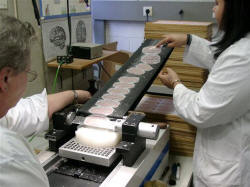 |
|


Digital 3-D atlas of brain reveals tiny details
[June 21, 2013] NEW YORK (AP) -- Scientists have a new brain atlas to help them study their favorite organ. It's a digital, three-dimensional model called "BigBrain."
|
Its resolution is finer than a human hair, so it can reveal clusters of brain cells and even some large individual cells. It is being made available to scientists around the world. To make the atlas, researchers sliced a cadaver brain from a 65-year-old woman into 7,400 thin sections, stained them to reveal tiny features, and photographed each one. Then they used computers to combine the data into a 3-D digital model. The idea of thin-slicing a brain to study its anatomy is not new. In fact, complete bodies of a man and a woman were sliced and photographed about 20 years ago to create an anatomy reference called the Visible Human Project. For the new brain-mapping project, the researchers chose the woman's brain for no special reason other than it was basically healthy, said Katrin Amunts of Heinrich Heine University Duesseldorf in Germany. She is lead author of a report on the atlas published Thursday in the journal Science. Scientists have begun mapping data from other brain studies onto the new model to gain new insights, said senior author Karl Zilles of the Juelich Aachen Research Alliance in Juelich, Germany. ___ Science: http://www.sciencemag.org/ |


